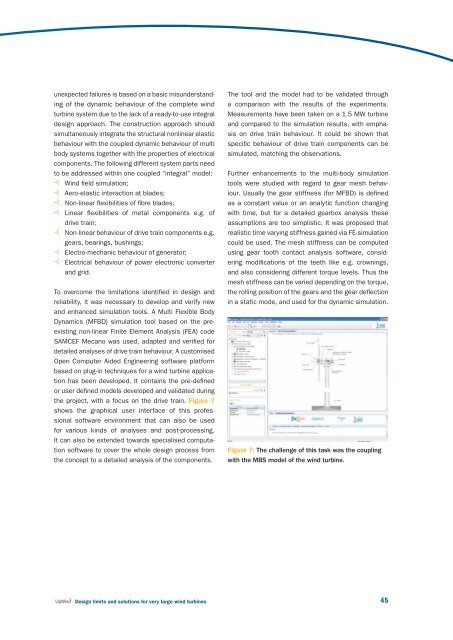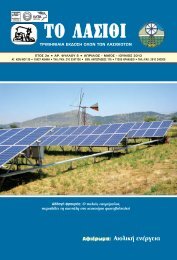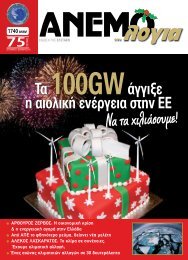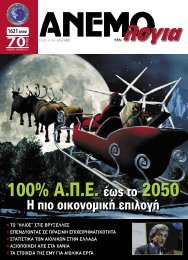Design limits and solutions for very large wind turbines
Design limits and solutions for very large wind turbines
Design limits and solutions for very large wind turbines
Create successful ePaper yourself
Turn your PDF publications into a flip-book with our unique Google optimized e-Paper software.
unexpected failures is based on a basic misunderst<strong>and</strong>ing<br />
of the dynamic behaviour of the complete <strong>wind</strong><br />
turbine system due to the lack of a ready-to-use integral<br />
design approach. The construction approach should<br />
simultaneously integrate the structural nonlinear elastic<br />
behaviour with the coupled dynamic behaviour of multi<br />
body systems together with the properties of electrical<br />
components. The following different system parts need<br />
to be addressed within one coupled “integral” model:<br />
Wind fi eld simulation;<br />
Aero-elastic interaction at blades;<br />
Non-linear fl exibilities of fi bre blades;<br />
Linear fl exibilities of metal components e.g. of<br />
drive train;<br />
Non-linear behaviour of drive train components e.g.<br />
gears, bearings, bushings;<br />
Electro-mechanic behaviour of generator;<br />
Electrical behaviour of power electronic converter<br />
<strong>and</strong> grid.<br />
To overcome the limitations identifi ed in design <strong>and</strong><br />
reliability, it was necessary to develop <strong>and</strong> verify new<br />
<strong>and</strong> enhanced simulation tools. A Multi Flexible Body<br />
Dynamics (MFBD) simulation tool based on the preexisting<br />
non-linear Finite Element Analysis (FEA) code<br />
SAMCEF Mecano was used, adapted <strong>and</strong> verifi ed <strong>for</strong><br />
detailed analyses of drive train behaviour. A customised<br />
Open Computer Aided Engineering software plat<strong>for</strong>m<br />
based on plug-in techniques <strong>for</strong> a <strong>wind</strong> turbine application<br />
has been developed. It contains the pre-defined<br />
or user defi ned models developed <strong>and</strong> validated during<br />
the project, with a focus on the drive train. Figure 7<br />
shows the graphical user interface of this professional<br />
software environment that can also be used<br />
<strong>for</strong> various kinds of analyses <strong>and</strong> post-processing.<br />
It can also be extended towards specialised computation<br />
software to cover the whole design process from<br />
the concept to a detailed analysis of the components.<br />
The tool <strong>and</strong> the model had to be validated through<br />
a comparison with the results of the experiments.<br />
Measurements have been taken on a 1.5 MW turbine<br />
<strong>and</strong> compared to the simulation results, with emphasis<br />
on drive train behaviour. It could be shown that<br />
specifi c behaviour of drive train components can be<br />
simulated, matching the observations.<br />
Further enhancements to the multi-body simulation<br />
tools were studied with regard to gear mesh behaviour.<br />
Usually the gear stiffness (<strong>for</strong> MFBD) is defined<br />
as a constant value or an analytic function changing<br />
with time, but <strong>for</strong> a detailed gearbox analysis these<br />
assumptions are too simplistic. It was proposed that<br />
realistic time varying stiffness gained via FE-simulation<br />
could be used. The mesh stiffness can be computed<br />
using gear tooth contact analysis software, considering<br />
modifi cations of the teeth like e.g. crownings,<br />
<strong>and</strong> also considering different torque levels. Thus the<br />
mesh stiffness can be varied depending on the torque,<br />
the rolling position of the gears <strong>and</strong> the gear defl ection<br />
in a static mode, <strong>and</strong> used <strong>for</strong> the dynamic simulation.<br />
Figure 7: The challenge of this task was the coupling<br />
with the MBS model of the <strong>wind</strong> turbine.<br />
<strong>Design</strong> <strong>limits</strong> <strong>and</strong> <strong>solutions</strong> <strong>for</strong> <strong>very</strong> <strong>large</strong> <strong>wind</strong> <strong>turbines</strong><br />
45









